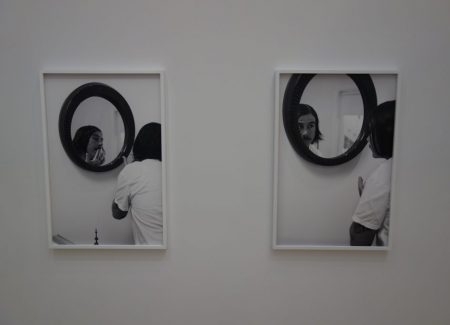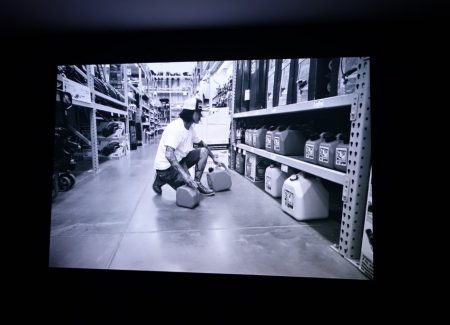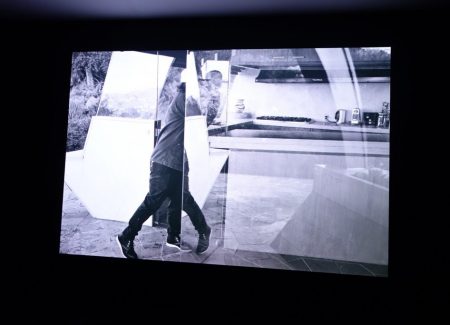JTF (just the facts): A total of 24 black and white and color photographs, framed in white and unmatted, and hung against white walls in the entry gallery, the main gallery space, and the downstairs foyer. All of the works are pigment prints, made in 2016. Physical sizes are either roughly 20×16, 40×27, or 64×96 inches, and all of the prints are available in editions of 5. (Installation shots below.)
The show also includes an HD video projection with sound (constructed from 852 black and white photographs), made in 2017. Its duration is 21 minutes 44 seconds, and the work is available in an edition of 5. (Stills below.)
Comments/Context: It takes a certain kind of intense disillusionment to decide to deliberately set fire to your own dreams. The volatile mindset that harbors thoughts of such an action might be incrementally constructed from parts raw anger, fatigue, ardent hope and reverence turned sour, and a grim fascination with destruction, and it is this heady mix of responses and impulses that provides the charged emotional landscape for Catherine Opie’s new body of work. With the current political climate and the raging wildfires of Southern California as a resonant backdrop, Opie is potently responding to watching the world burn.
Taking form as a video as well as a series of still photographs, The Modernist tells the story of a lone arsonist who is systematically torching the iconic modernist homes that dot the hills of Los Angeles. As the narrative unfolds, the unnamed protagonist (played by Opie’s longtime collaborator Stosh Fila aka Pig Pen) wakes up on the couch of his sleek one-room studio and begins to flip through coffee table books of modernist architecture, those ideas kicking off an improvisational artistic process of constructing a mural on the large white wall of his apartment, merging photographs of the buildings, drawn and painted additions, and cut out words and headlines.
In a cyclical corkscrew manner, we see him wake up each day, get the newspaper from outside his door (a faked version of the Los Angeles Times, mixing real political stories from the 2016 election with the fabricated articles about the fires on the front page), and read about his own exploits setting fire to one landmark house or another. He cuts out the pictures and methodically continues to add them to the mural, and then later sets off to burn the next target on his hit list (including several landmark John Lautner buildings, including the Chemosphere and the Sheats-Goldstein residence). This happens several times (with tense moments of trespassing with gas cans, lit matches, and ultimately billowing fires and fast getaways on foot), the repetition of each conquest increasing the flow of emotions that is building up inside him. In the in-between moments, he patiently smokes hand rolled cigarettes, considers the evolving mural, burns balsa wood scale models of the famous structures in his courtyard, and watches the momentary flares of matches with rapt attentiveness.
The video of The Modernist is not actually made from live action footage, but from still photographs arranged into sequence and slowly flipped like a time lapse. This approach is similar to the one used by Chris Marker in La Jetée, the pauses between frames allowing just enough time to notice the care with which Opie has composed her images and layered the pictures together. Interestingly, all of the stills in the video are oriented horizontally, while the stand alone photographs of the same material are all vertical, the cropping changing the way the we see (or remember) the same scenes. The film is largely silent, aside from one explosive swoosh of loud sound (a match creating a burst of flame) that blasted my fellow viewers into a tittering jangle of uneasiness.
The photographs Opie has chosen to single out from the larger flow circle around the idea of fascination – with fire itself, with the arsonist’s own reflection in the mirror of his studio, with self-fulfilled concentration and pride as the artistic wall collage grows (a full reproduction of the collage, and several smaller fragments are included as single images), with the bold action of starting the fires themselves, and with the image of being a solitary figure on a quest. Each image bends back in self-reflection, both obsessive looking and being seen (or obscured) as two sides of the same coin.
What Opie gets particularly right in both the video and the photographs is the nuanced range of emotions that the arsonist displays. We watch as he is hypnotized by the flames, mesmerized by simply looking at a match as it flickers and flares up (and is reflected in nearby glass), playing danger games with touching the fire as he smokes. We follow along as he reads the paper with satisfaction, his exploits and accomplishments worthy of celebration on the front page, each clipping a kind of trophy or talisman, proof that the media is paying attention and taking him seriously. And we stand behind him as he draws, and cuts, and obsessively overpaints the mural, each word, image, and gestural mark adding to the burgeoning aggregation of fury, his movements methodical as he circles the collage looking for angles for improvement.
In many ways, the whole enterprise is like a piece of performance art (or the nested documentation of such an artwork), except that it quietly moves beyond the esoteric to hit at harder truths. As much as the arsonist appreciates the icons of architecture he is destroying, and it is likely the utopian dreams for futuristic living that they represent are not lost on him, he has clearly been marginalized by the world he lives in – he’s not living the dream, and so these landmarks have been transformed, at least for him, into symbols (or artifacts) of that societal misalignment. He still sleeps on his couch, doesn’t appear to be employed, has plenty of time on his hands, and seems to be generally alone, and while Pig Pen has the outward trappings of masculinity, including a moustache and a lone wolf persona, his gender seems ambiguous, so perhaps he is an outsider in this way as well.
So while Opie’s project is in some ways a loving homage to the architecture of Los Angeles, it also blends in many other layers of metaphor and connection. The Modernist touches on income inequality (especially for artists), the evolving relationship between media and self-esteem, the twinned artistic polarities of destruction and creation, and the failure of society to make room for those on the margins. And seen through the prism of politics, the arsonist’s actions feel like a desperate shout to the world that he’s not being listened to and that the world is changing in ways he doesn’t like, his reaction born from a feeling of being frustrated and powerless. That the arsonist turns on the very structures that he so reveres, and that he literally stands by and watches as his dreams burn, feels like a particularly dispiriting reflection of the mood of our current times. Opie’s delivery of such a message with such layered subtlety is a testament to the maturity of her photographic vision.
Collector’s POV: The prints in this show rage in price from $15000 to $65000, based on size. Opie’s work has started to show up in the secondary markets with more regularity in recent years, with prices ranging between roughly $2000 and nearly $300000.



































